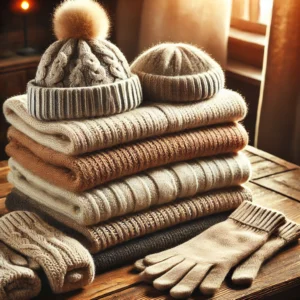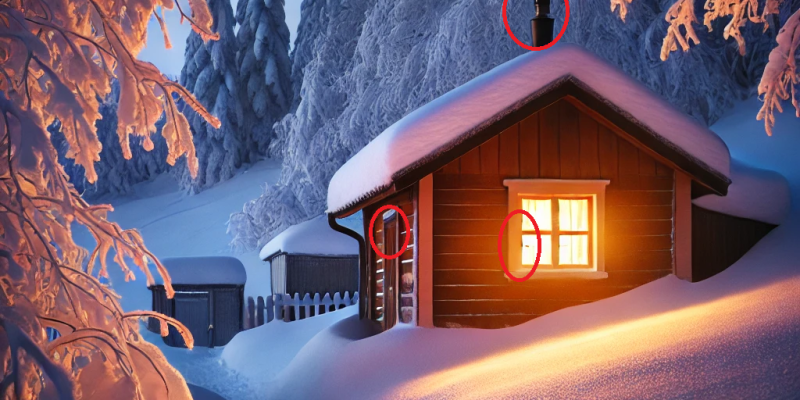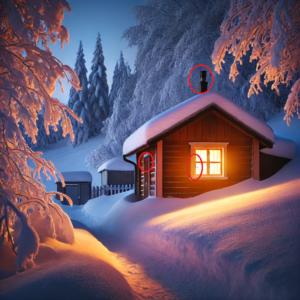Have you ever woken up to a bitter cold morning, only to find your heater isn’t working? Maybe the power went out during a snowstorm, or your furnace broke when you needed it most. When freezing temperatures strike, losing heat isn’t just uncomfortable—it can pose a real danger. Fortunately, you can rely on several time-tested methods to keep warm without resorting to expensive equipment.
Below, you’ll discover six strategies that can help you maintain a safe temperature when the mercury drops. These ideas don’t require specialized skills or elaborate gear. Instead, they focus on what you already have, or what you can get at low cost. Staying warm doesn’t have to be complicated. Sometimes, small choices make a big difference.
1. Dress in Layers for Maximum Warmth
Layers trap body heat better than a single bulky item. Start with a thin base layer made from a material that wicks moisture away from your skin—something like polyester or wool blends. Over that, add an insulating layer such as a sweater or fleece. This layer holds in heat. Top it off with something that blocks wind or moisture if you must go outside. Don’t forget a hat or beanie. Since much of your body heat can escape through your head, covering it helps keep the warmth you generate.

Think about your hands and feet, too. Gloves or mittens, along with thick socks, protect your extremities from the cold. If you’re indoors and still feel chilly, you can slip on a light pair of gloves. The air space between each layer is key to maintaining warmth, so don’t overlook the power of a few well-chosen pieces of clothing.
2. Seal Off Drafts and Focus on a Small Space
When the heater is off, your main enemy is heat loss. Small leaks around doors and windows can make a big difference in how cold your space gets. Check for cracks and gaps, and seal them with duct tape or any sturdy tape you have on hand. Even rolled-up towels pushed against the base of doors can help block incoming cold air.
A well-insulated space retains warmth for longer. If you live in a house, choose a smaller room and focus on keeping just that area warm. Hang blankets or heavy curtains over windows to reduce heat transfer. If you have a fireplace or wood-burning stove, concentrate your efforts near it. By shrinking your living area, you reduce the volume of air you need to keep warm, which makes a noticeable difference when the temperature outside is dropping fast.
3. Harness the Power of Your Own Body Heat
Your body is a natural furnace. If you’re not moving around, that furnace runs on low. A mild exercise routine can help increase your body temperature. Simple moves like jumping jacks, push-ups, or even dancing in place can get your blood flowing. After a few minutes of activity, you’ll feel warmer from the inside out.

Once you’ve generated that extra heat, hold onto it. Wrap yourself in blankets immediately after exercising. Better yet, share body heat if you’re with family or friends. Sitting close together under blankets raises the temperature in your immediate area. Pets also generate heat, so letting your dog or cat sit next to you can make a noticeable difference.
4. Get Creative with Insulation and Heat Sources
Emergency situations call for resourcefulness. If you have candles, they can provide a surprising amount of heat in a small, enclosed room. Always be careful with open flames. Keep them away from flammable materials and never leave them unattended. Reflective surfaces can bounce candlelight and heat around a small space. If you have aluminum foil, you can use it to line a cardboard box, creating a makeshift heat reflector.

You might also consider filling containers with hot water if you can still heat water on a gas stove or wood-burning stove. Metal or thick plastic bottles placed under blankets act like hot water bottles. They lose warmth slowly, giving you a steady heat source for your hands or feet.
5. Eat and Drink Warm, Nourishing Food
Warm soups, stews, or even hot water with herbs and spices can help maintain your core body temperature. If you have the ability to cook, focus on meals that are high in protein and fats—foods like beans, rice with oil, peanut butter, or oatmeal. These foods provide sustained energy, which your body uses to keep itself warm.

Drinking warm beverages throughout the day also helps. Try herbal teas, coffee, or even just warm water if that’s all you have. Sipping hot liquids won’t replace your heater, but it can keep your internal furnace running efficiently. Plus, holding a hot mug in your hands feels comforting and boosts morale when it’s frosty outside.
6. Use Physical Barriers for Additional Warmth
It might sound old-fashioned, but piling up blankets or using sleeping bags designed for camping can really help. If you’ve ever camped in cold weather, you know how important layers of insulation are. Consider creating a tent-like space in your living room using blankets draped over chairs or a table. The smaller interior helps trap body heat and keeps a lower volume of air warm.

Some people even use thick cardboard or foam sheets against walls and windows to create extra insulation barriers. If you live in an area where winters are severe, it might be worth keeping foam boards in storage. They come in handy when drafts are too strong for tapes and towels to handle.
Remembering Practical Safety
Whenever you rely on alternative methods for heat or light, safety is your top priority. Never leave open flames unattended, and ensure you have good airflow if you’re burning anything indoors. Carbon monoxide poisoning can be a real threat if you’re using a grill, camp stove, or generator inside. Also, avoid sleeping with open flames nearby. A warm room isn’t worth a safety hazard.
Keep a fire extinguisher or large container of water on hand if you’re lighting candles or starting any sort of fire. Good ventilation, prudent supervision, and caution can go a long way toward keeping you and your family safe.
Practical Benefits of Planning Ahead
Staying warm without a heater is easier when you have some basic items ready. Cheap insulation materials like duct tape, plastic sheeting, and old blankets can help you weather unexpected cold snaps. If you can set aside a small budget each month, consider investing in wool clothing or thermal underwear. Those items might cost more upfront, but they can save you from discomfort—or worse—when outdoor temperatures plummet.
Above all, remember that mental preparation matters as much as physical supplies. If you know what steps to take, you’ll act faster and with more confidence when a cold-weather emergency arises. That calm and organized approach can make the difference between struggling and thriving.
Conclusion
Experiencing freezing temperatures without a functioning heater can be daunting, but it doesn’t have to be disastrous. By layering your clothes, sealing off drafts, and finding creative ways to generate small amounts of heat, you can stay significantly warmer. Improvised methods may seem simplistic, yet they’ve helped people survive harsh winters for generations.
Preparing now—even if it’s something as straightforward as storing extra blankets and duct tape—can save you a world of trouble later. When winter storms arrive or a power outage leaves you in the cold, you’ll have a plan of action. With resourcefulness, foresight, and steady nerves, you and your family can keep warm until the heat comes back.






